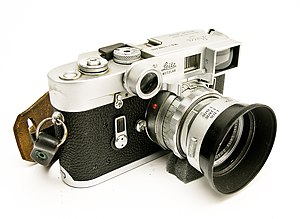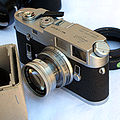Leica M4
This article needs additional citations for verification. (December 2013) |
 Leica M4 with 50mm f/2 and proxiphotography glasses | |
| Overview | |
|---|---|
| Type | 35 mm camera |
| Lens | |
| Lens mount | Leica M-mount |
| Focusing | |
| Focus | manual |
| Exposure/metering | |
| Exposure | manual |
| Flash | |
| Flash | Connectors for bulb and electronic flash |
| General | |
| Dimensions | 138 x 77 x 33.5 mm |
| Weight | 560 g |
The Leica M4 is a 35 mm rangefinder camera produced by Ernst Leitz GmbH.
Leica M4[edit]
The M4 started production in November 1966, as the direct successor of the M3 and M2, featuring framelines for 35 mm, 50 mm, 90 mm and 135 mm lenses in a 0.72 magnification viewfinder. It has the frame counter of the M3, with automatic reset after reloading. The M4 was the last Leica rangefinder of this era to be predominantly hand-built.
Three ergonomic modifications were introduced in the M4:
- an articulating film advance lever, modernised self-timer and frame selection levers
- an angled crank for rewinding the film that replaced the slow to use telescopic knob of the M3
- a faster loading system that does not require use of a removable spool
Production of the Leica M4 ceased in 1975.
An olive coloured Leica M4, originally designed for the West German Army, sold at auction in 2009 for €87,600.[1]
Leica MDa[edit]
A scientific version without a viewfinder was made as the Leica MDa (similar to the Leica M1).

Leica M4-2, Leica M4-P[edit]
Production of the M4 stopped briefly in 1972. Its successor, the M5 had been introduced in 1971. However, the relatively bulky and expensive M5 met with a cool reception, and sales did not live up to Leica's expectations. Production of the M4 was therefore restarted quickly until 1975. In the year 1975, a special edition was made for Leica's 50th Anniversary, and in 1977 the company launched the updated M4-2, which was based on the M4's body, but with a streamlined production process that reduced manufacturing cost. The M4-2 added a hot shoe and motor drive compatibility as standard, but removed the self-timer.
The M4-2 was followed in 1981 by the M4-P, which added framelines for 28 mm and 75 mm lenses. The range continued with the Leica M6 in 1984, which was essentially an M4-P with through-the-lens (TTL) light metering. The M4-P finally ceased production in 1986[2]
-
Leica MDa
-
Classic M4 with the rewinding crank well visible
-
Leica M4-2 with motor drive
-
Leica M4-P
-
Leica M4 with M3-like levers, a popular cosmetic change
References[edit]
- ^ "Distinctive Leica M4 sets new auction record". British Journal of Photography. 156 (7738). Incisive Media: 8. 2009.
- ^ Leica Serial Numbers: M and R Sorted by Number
External links[edit]
![]() Media related to Leica M4 at Wikimedia Commons
Media related to Leica M4 at Wikimedia Commons






